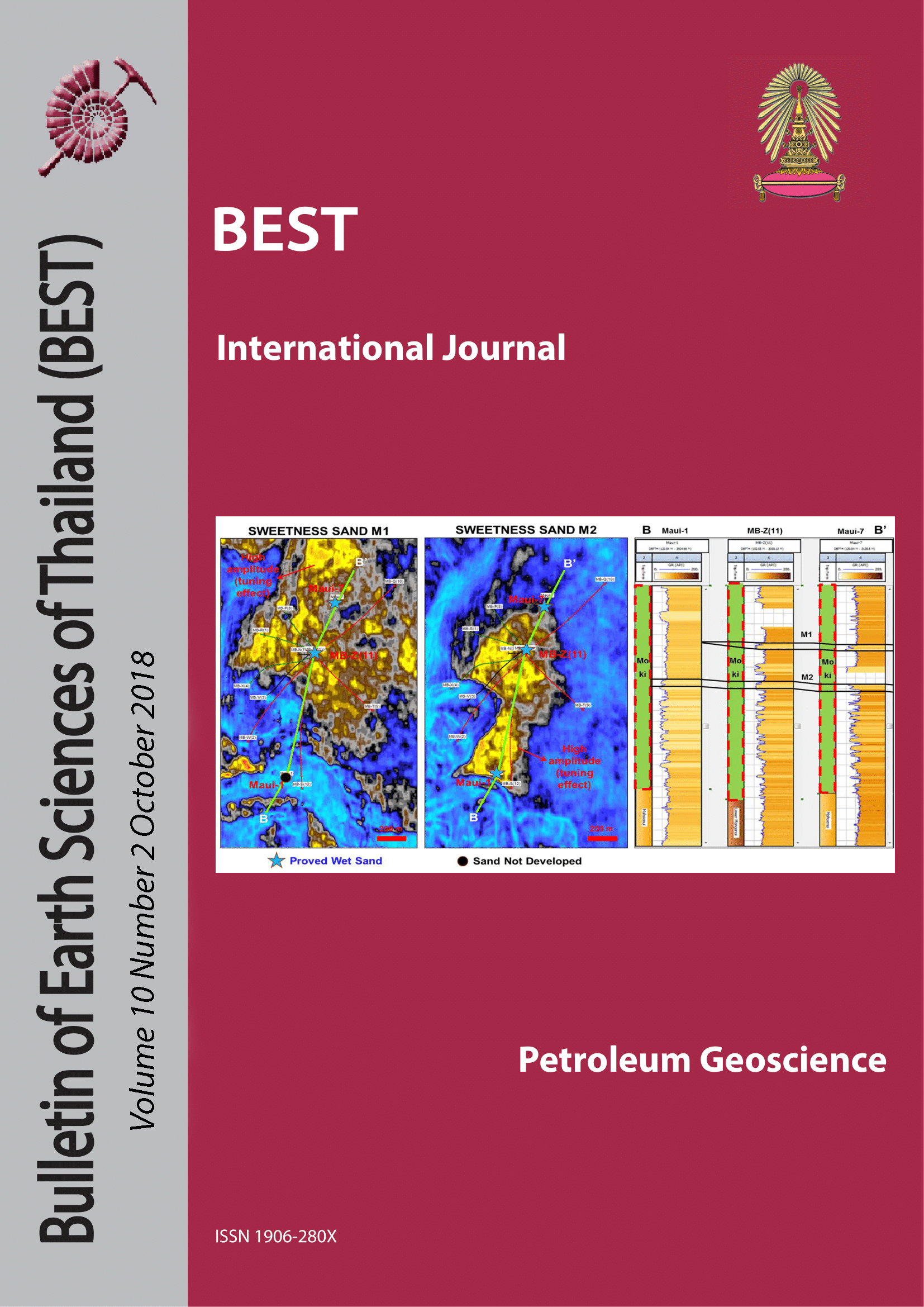Fracture Development in Phanok Khao Reservoirs from Outcrop Integrated with FMI, Korat Basin, North-East Thailand
Main Article Content
Abstract
Production from fractured carbonate reservoirs in North-East Thailand has been ongoing in the Phu Horm field and focused in the “Pha Nok Kao Formation”. There, the relative timing of fracture events, the relationship to fluid-cement histories, and ties to the Indosinian or Himalayan Orogenies are not well understood. Therefore, in an attempt to look more regionally at defining effects from both tectonic events, this study focused on three outcrops across North-East to Western Thailand, where previous mapping has shown structures related to both orogenic events are present. The selected areas are; Chum Phae quarry, Banphot Phisai quarry and U-Thong quarry. The most significant area is the Chum Phae quarry, which contains lithologies, structures and diagenetic features that can be directly related to the Pha Nok Kao reservoirs in Sinphuhorm field.
Fracture orientation analysis was integrated with petrographic study to better define relative timing and model the structural geometry with the integration of fracture development across the three areas. Stable isotope crossplots of carbon and oxygen (C-O), using orientation-aware isotope samples, defined variable fluid events, which can classify the diagenetic evolution in each fracture. The isotopic plotfields define 2 trends of reactivated fractures that experienced crossflows of deep mixing meteoric waters during later tectonic uplift. Moreover, North-East Thailand in the vicinity of Sinphuhorm field did not experience significant cross-flows of Indosinian deformation fluids, nor the Mesozoic hydrothermal fluids that have overprinted once-fractured metamorphic carbonates in Central and Western Thailand. The highest potential for open fracture trends is found in fractured carbonates preserving isotopic evidence of being subject to reactivation during the youngest tectonic event (Himalayan Orogeny).
Article Details

This work is licensed under a Creative Commons Attribution-NonCommercial-NoDerivatives 4.0 International License.
Copyright © 2008 Department of Geology, Faculty of Science, Chulalongkorn University. Parts of an article can be photocopied or reproduced without prior written permission from the author(s), but due acknowledgments should be stated or cited accordingly.
References
Allegre, C. J., 2008. Isotope Geology. Cambridge University Press, p.512.
Bunpitaksakul, T., 2016. Poroperm Controls in Outcrop Analogs for “Ordovician” Fractured Carbonate Reservoirs in Suphanburi Basin, Western Thailand. Thailand. Bulletin of Earth Sciences of Thailand, Vol. 8, No. 2.
DMR, 1976. Geological map of Changwat Nakon Sawan (1:250,000).
DMR, 1976. Geological map of Changwat Suphanburi (1:250,000).
DMR, 1984. Geological map of Changwat Phetchabun (1:250,000).
Dunham, Robert J., 1962. Classification of Carbonate Rocks According To Depositional Textures. pp.108-121.
Fayers, S. R., and Trewin, N. H., 2003. A Review of The Palaeoenvironments and Biota of The Windyfield Chert. Earth and Environmental Science Transactions of The Royal Society of Edinburgh, 94(4), pp.325339.
Flugel, E., 2010. Microfacies Data: Fabrics In Microfacies of Carbonate Rocks. Springer, Berlin, Heidelberg. pp.177-242.
Hess, 2007. FMI Interpretation Report, Internal Report. PTT Exploration and Production Co., Ltd., p.43.
Hoefs, J., 2009. Stable Isotope Geochemistry. Springer, Berlin, Vol. 201, p.285.
Khattak, O., 2017. Type of Fractures. http:// geologylearn.blogspot.com
Longman, M. W., 1980. Carbonate Diagenetic Textures from Near Surface Diagenetic Environments. AAPG bulletin, 64(4), pp.461487.
Lucia, F. J., 2007. Carbonate reservoir characterization: An integrated approach. Springer Science & Business Media, 336 p.
Morley, C. K., Charusiri, P., and Watkinson, I. M., 2011. Structural Geology of Thailand During The Cenozoic. The Geology of Thailand, p.273.
Nelson, R. A., 2001. Geologic Analysis of Naturally Fractured Reservoirs. Gulf Professional Publishing, 332 p.
Panthong, A., 2015. Facies Distribution and Diagenetic Evolution of A Carbonate Reservoir In Pha Nok Khao Formation, Sinphuhorm, Thailand. Bulletin of Earth Sciences of Thailand, Vol. 8, No. 2, pp.1-11.
Polachan, S., Pradidtan, S., Tongtaow, C., Janmaha, S., Intarawijitr, K., and Sangsuwan, C., 1991. Development of Cenozoic basins in Thailand. Marine and Petroleum Geology, 8(1), pp.84-97.
Ridd, M. F., Barber, A. J., and Crow, M. J., 2011. The Geology of Thailand. Geological Society of London.
Scholle, P. A., 2003. A Color Guide to the Petrography of Carbonate Rocks: Grains, textures, porosity, diagenesis. American Association of Petroleum Geologists, 470 p.
Singhal, B. B. S., and Gupta, R. P., 2010. Fractures and Discontinuities. In Applied Hydrogeology of Fractured Rocks. Springer, Dordrecht, pp.13-33.
Tucker, M. E., 1996. Sedimentary Rock in The Field. Department of Geological Sciences University of Durham, UK, 3rd edition.
Ueno, K. and Charoentitirat, T., 2011. Carbonifeous and Permian. The Geology of Thailand,pp.71-136.
Ulmer-Sholle, D.S., and Scholle, P. A., 1994.
Relacement of Evaporites within The Permian Park City Formation, Bighorn Basin, Wyoming, USA. Sedimentology, 41(6), pp.1203-1222.
Warren, J., Morley, C. K., Charoentitirat, T., Cartwright, I., Ampaiwan, P., Khositchaisri, P., & Yingyuen, J., 2014. Structural and Fluid Evolution of Saraburi Group Sedimentary Carbonates, Central Thailand: A Tectonically Driven Fluid System. Marine and Petroleum Geology, 55, pp.100-121
Wayne, M. A., 2008. Geology of Carbonate Reservoirs: The Identification, Description, and Characterization of Hydrocarbon Reservoirs in Carbonate Rocks, John Wiley & Sons, Inc, p.277.


